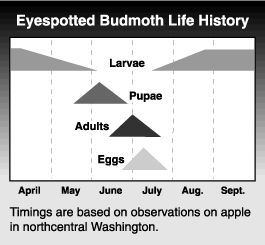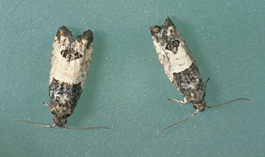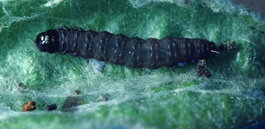by Jay F. Brunner, originally published 1993
Spilonota ocellana (Denis and Schiffermüller) (Lepidoptera: Tortricidae)
This insect, introduced from Europe before 1840, is now common throughout the northern United States and southern Canada. It is most common in abandoned orchards or native vegetation and is rare in commercial orchards.
Hosts
The eyespotted budmoth feeds on apple, pear and all stone fruits, as well as on deciduous trees such as hawthorn, oak, beech, larch, and alder. It prefers rosaceous plants.
Life stages
Egg
The egg is oval, flattened, and is a translucent, creamy white.
Larva
The body is a dull chocolate brown, while the head and thoracic shield are shiny dark brown to black. When full grown the larva is 3/4 to 1 inch (18 to 25 mm) long.
Pupa
The pupa is golden brown and resembles a leafroller pupa.
Adult
The adult moth is marked by large gray and white areas on the wings. When at rest, it has a broad white band across the middle of the wing, while the front and rear are gray.
Life history
 The eyespotted budmoth has only one generation per year. It overwinters as a partially grown larva within a hibernaculum in crotches of small diameter wood. Larvae become active in spring as buds begin to show green tissue. The young larva first burrows into a bud, feeding on the leaf and flower parts. Later in the spring, the larva forms a tubular feeding nest by webbing together several leaves and flower parts of a spur or growing tip.
The eyespotted budmoth has only one generation per year. It overwinters as a partially grown larva within a hibernaculum in crotches of small diameter wood. Larvae become active in spring as buds begin to show green tissue. The young larva first burrows into a bud, feeding on the leaf and flower parts. Later in the spring, the larva forms a tubular feeding nest by webbing together several leaves and flower parts of a spur or growing tip.
The nest may contain one or more dying or dead leaves produced by the larva partially severing the petioles of leaves in the cluster. The first larvae are full grown by late May or early June. When mature, they pupate within the feeding nest. The pupal stage lasts 10 to 15 days. Adults begin to emerge in mid- to late June, with the flight continuing into July. Eggs are laid singly, usually on the lower surfaces of leaves, and incubation takes 7 to 14 days. Larvae begin feeding on lower leaf surfaces, constructing feeding sites near the midribs. The sites are covered by silken webs strewn with frass. Leaves touching one another or a leaf touching an apple are also desirable feeding sites. Development continues until larvae are half grown, usually by late July or early August, when they leave feeding sites and construct hibernacula. The larvae incorporate bits of frass and plant parts into the hibernacula so that after some weathering they appear similar to the bark and are inconspicuous.
Damage
Feeding by larvae on buds and blossoms in early spring is not a problem unless populations are very high. Boring of larvae into growing shoots can be serious in young trees or nursery stock where it results in restricted growth or abnormal tree form. Larval feeding on fruit is most important. Feeding on fruit by mature larvae just after bloom results in damage similar to that caused by early season leafroller feeding. Feeding on fruit by young larvae in mid- to late summer results in a cluster of tiny, circular excavations in the fruit. These excavations are not deep and are usually separated from each other. They can look very similar to damage caused by young leafroller larvae in midsummer.
Monitoring
Overwintered larvae can easily be found by examining foliage prebloom. The tubular feeding nests resemble those made by leafrollers. While monitoring orchards in July and August, watch for leaves attached to the side of apples. The color of the eyespotted budmoth larva helps distinguish it from leafrollers that might be there at the same time. Adult activity can be monitored with a pheromone trap.
Biological control
Several species of parasitic wasps have been reported to attack larvae of the eyespotted budmoth in unsprayed habitats. It is unclear how effective natural enemies would be in a commercial orchard.
Management
The best time to suppress eyespotted budmoth is before bloom. Treatments targeted at overwintering leafroller larvae will also control larvae of the eyespotted budmoth. This insect is relatively easy to control with conventional neurotoxic insecticides used in orchards to control other pests, which explains why it is seldom reported as a significant pest.


